I present three separate blog posts dealing with the three projects and their exercises as presented in this course material, then a seperate post with research questions as well as another for Assignment Two.
Project 1: Working Space – The studio as a subject
EXERCISE 1.1. Working Space
Research the studio of Francis Bacon and write a short 300-word analysis of
what you have found in your learning log.
I found a Youtube video to view this work and understand the process of how his studio became an exhibition area in a gallery.
The studio was donated to the Hugh Lane Gallery in Dublin in 1998 and has been on public view since 2001. It is shown as being a mess, clearly a space where work is taking place. This space was designed by David Chipperfield and consists of a series of rooms – in one space there is a small cinema that screens an interview between the artists and Melvyn Bragg.
I can imagine how overwhelming it must have been for the curators to walk into his studio after his passing, take in the space, and then catalog and pack up and dismantle it to re-produce the space as faithfully as possible. I learned that areas of the wall were cut out to preserve his finger marks and paintings on the walls. I read that there are touch-screen interactive terminals that allow visitors to explore the studio contents. It seems there were over 7,000 objects logged and painstakingly transferred. This work is also accompanied by an online database that forms the first computerized record of the entire contents of an artist’s studio. Interesting to read that, being typical of Bacon’s practice, some of the contents that were gathered included scraps of thick corduroy trousers, cut-out arrows, and toweling dressing gowns he would have used to texture paintings.
I also think that by going through all the objects in this studio one would get a good insight into what inspired Bacon. It was known that he relied a lot on photographic images as well as that of his earlier paintings – did it motivate or inspire? It was interesting to learn how he used photo images of figures, he would tear or fold them, put them together as a new form, and almost get a different pictorial idea, which is so much like the work he was producing. I think it gives a great insight into how he manipulated his objects/subjects in his very unique way of painting. In the commentary on the video, it was remarked that it became ‘preparatory sketches’. I also found it interesting to think that his photo images are covered with his own paint-smeared fingerprints.
I later found an ArtRoom video where I learned about his interest in how photographic images with movement interested him – distorted images became his bigger interest, a sort of excitement from his perspective. These could be seen in images he had of wrestling and boxing figures. He described these photographic images in this video as his ‘models’ and ‘subject matter’. (8:24/8:53) It was also discovered that he did do drawings before he would paint – something he had denied in earlier conversations with him.
“….the mess around us is rather like my mind; it may be a good image of what goes on inside me, what it’s like, my life is like that”.
One gets the idea that all this stuff in his studio was part of his subject matter – contained in this space where he worked and obviously found inspiration from it. I learned that he liked to work in the early hours of the morning, and preferred to be alone whilst working.
I can completely relate to the chaotic idea, and I also do not have the answer to why it is like that, but I would try to get some order in my studio, use the shelves and drawers to file, try to dust, organize, but within an hour of being busy here, it is a mess again. I will not consider using the walls to clean brushes and routinely clean brushes and close lids of paint/ink, but I know I will not feel authentic to myself if my studio was organized like a library and always tidy and organized. I do like my desk area, where my computer is, to be more organized, but books, pens, and found objects also find their way onto this space and I sometimes have to scrape an area clean for writing or making small sketches- those on the go ideas that need to be explored without using an easel or many materials. There was a time in my life that I would make a makeshift working space in my bedroom – this led to chaos, as I found that everything around me had value and could contribute to my making, but was interfering with the privacy and luxury of having a bedroom – and, my husband did not appreciate this intrusion.
I am comfortable with the chaos around me here in my studio and I think nature is many times the same; the wind could suddenly blow or rain could pour down – I will still be happy to work, and I am sure I take those visuals with me in my explorations. I mentioned that I am a bit of a Magpie and do think there are opportunities hidden in ‘things’ that are gathered without a specific order – I even think there is beauty in that. I have started to place my ‘found objects’ into spaces I curate for them, like on a table or in my curiosity cabinet (recently, my 5-year-old grandson discovered that these are his best discovery/explorative/playful spaces as well)
LIST OF ILLUSTRATIONS
Fig. 1. Francis Bacon’s A Terrible Beauty [Online Video] At: https://youtu.be/xM1eeKHNrE4 (Accessed on 02/01/2023)
BIBLIOGRAPHY
Laster, Paul. (2020) The Skeletons in Francis Bacon’s Studio: Art and Object 21/09/2020. At: www.artandobject.com (Accessed on 03/01/2023).
Dawson, Barbara. (2020) The Secret Life of an Artist Studio Hugh Lane Gallery [Download] At: https://youtu.be/aY7BmJEHfQs/ (Accessed on 03/01/2023).
The ArtRoom1 (2010) Francis Bacon Documentary Part 3. [Download] At: Youtube.com/watch?v=Bsv2RdD3cvw/ (Accessed 02/01/2022)
Jones Caitlin. (2010). When the studio is a laptop [Pdf Download] At: https://faa218.files.wordpress.com/2014/08/jones_caitlin.pdf (Accessed on 02/01/2023).
Artist’s Studio Museum Network (2022). Francis Bacon Studio. At: https://www.artiststudiomuseum.org/studio-museums/francis-bacon-studio/ (Accessed on 02/01/2023).
Exercise 1.2 My studio
I am reminded of Daniel Buren:
Here are his answers to his question, “what is the function of the studio?”:
- It is the place where the work originates.
- It is generally a private place, an ivory tower perhaps.
- It is a stationary place where portable objects are produced.
I am aware of the relationship between my making and the space I am working in: some areas have become research corners, for example, where spores or mushrooms are growing and where I make spore prints, where I draw, and where I store work. I have two working tables, one for standing and the other for sitting; I also have a glass-top table, which functions as a desk for my computer and where I do mostly reading and research.
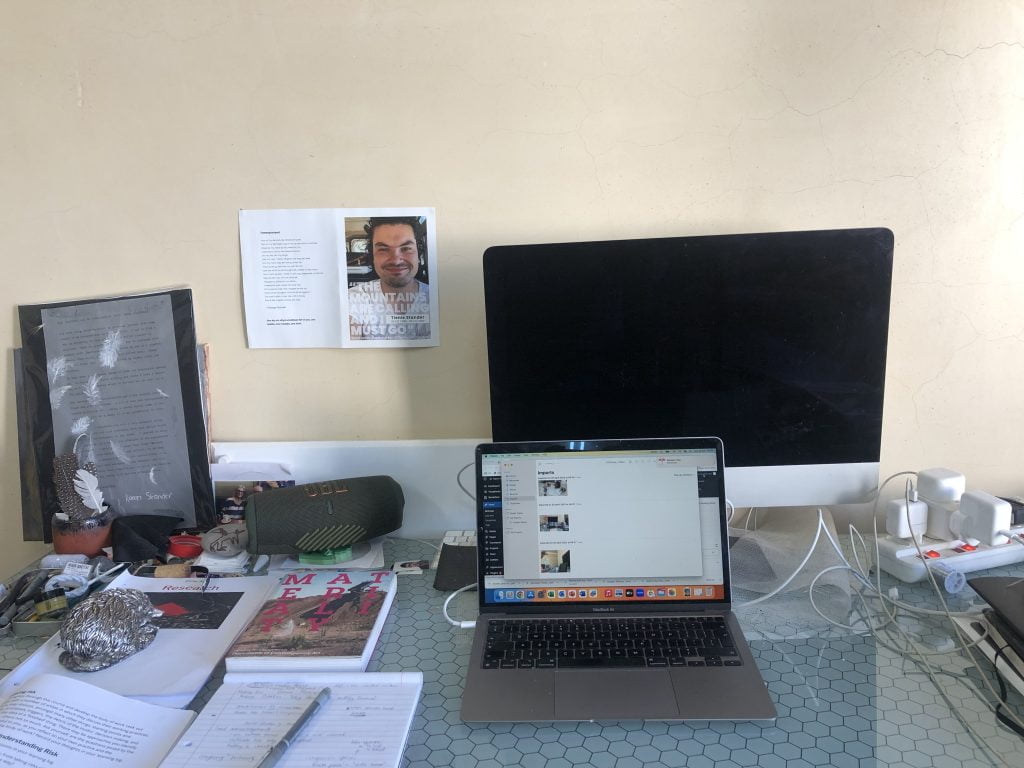
I have two big easels, a book cabinet, 3 bookshelves, trolley on wheels for paint, a big chest of drawers for drawings and bigger work on paper, and a little wundercabinet in my studio. My favorite piece of furniture is the chest of drawers with extra big drawers where I can archive work – my husband made it, and because it runs on caster wheels, it is very quickly moveable and accessible.
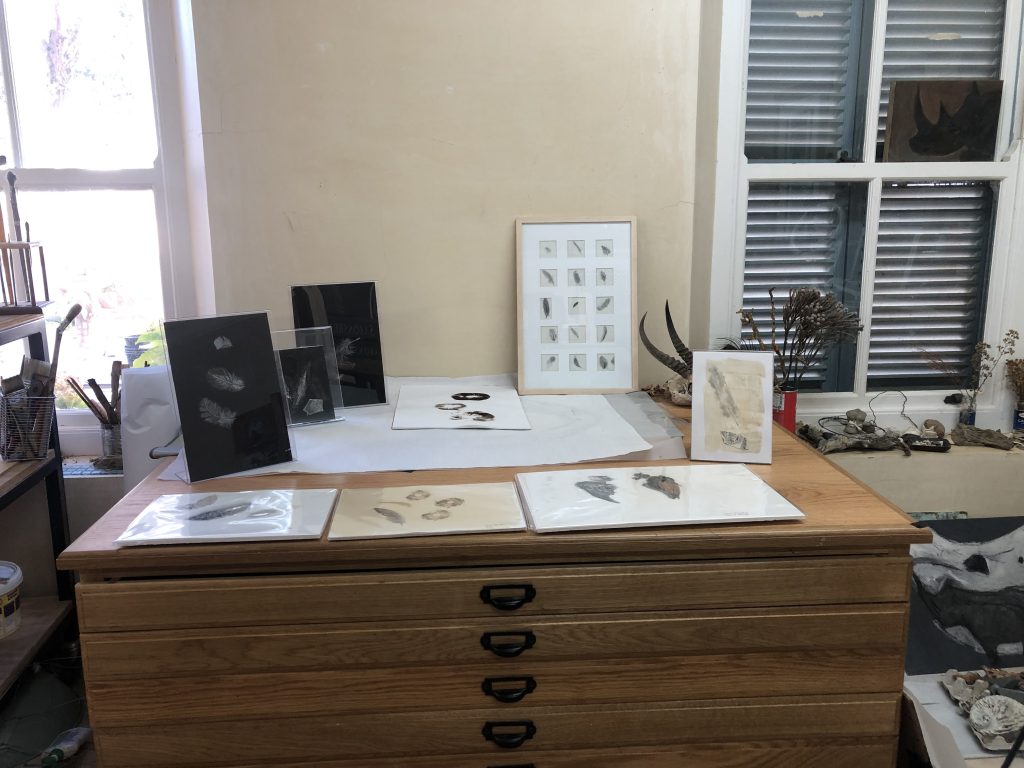
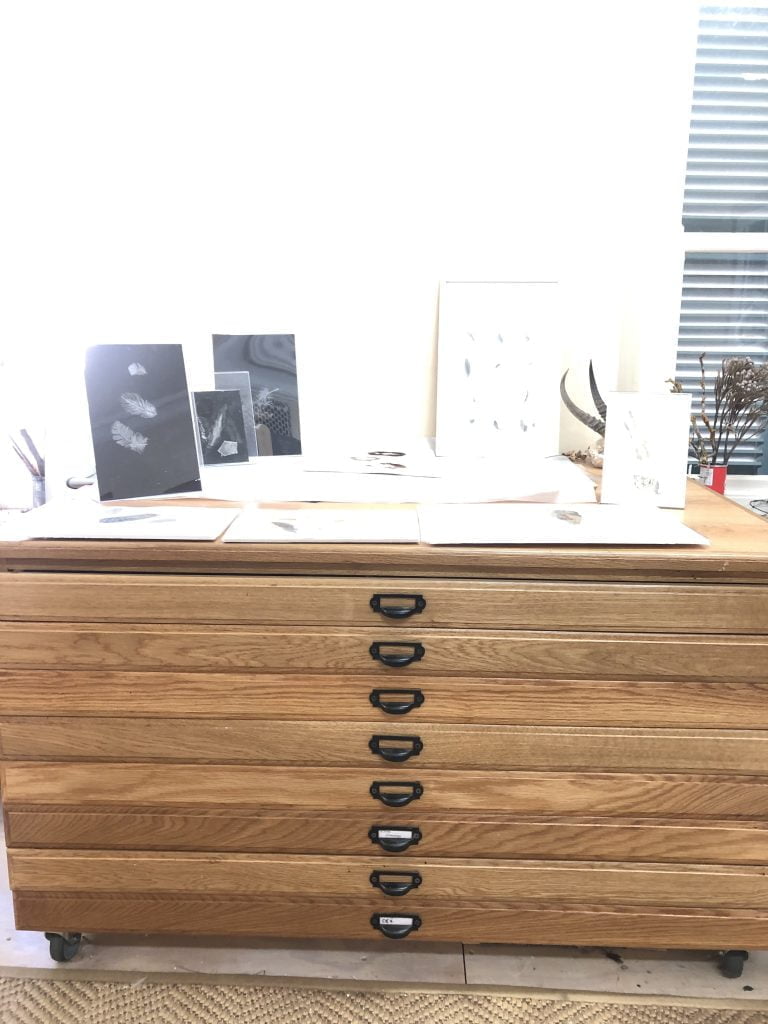
Some work is on a smaller table, and I have work on the floor. I have three chairs, two with wheels, in my studio. I have good electric lighting and light from windows and doors coming into the studio. My grandchildren visit my studio regularly – here we draw or paint together. On the image below my middle son joined a playful session in my studio.
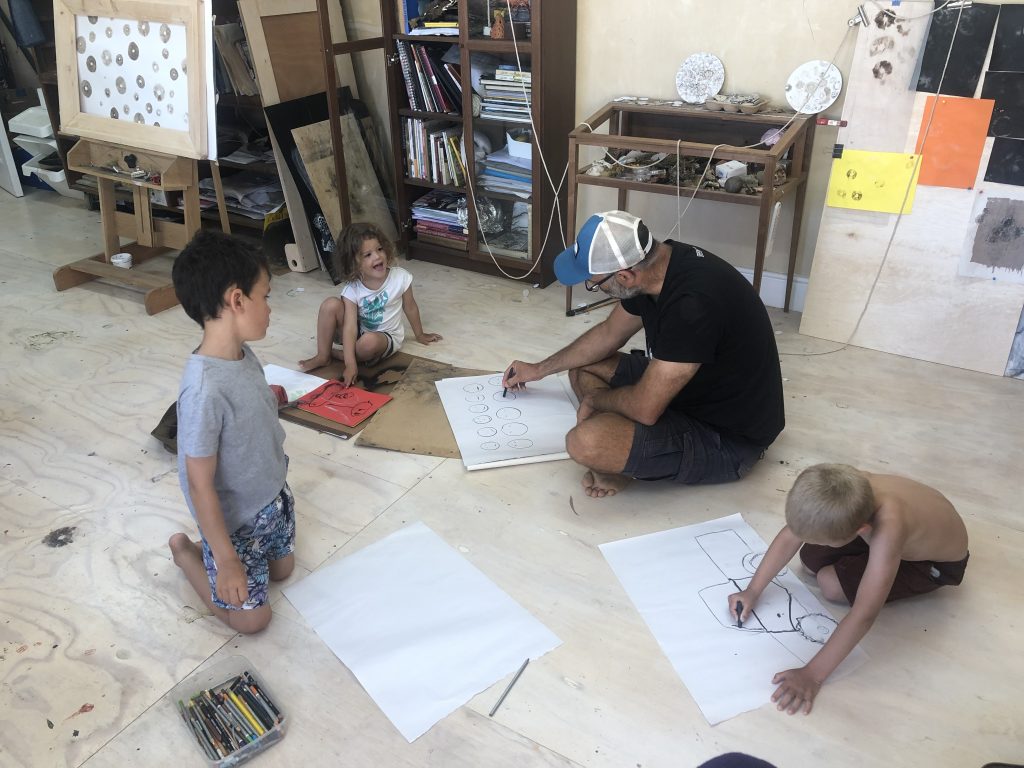
Two doors enter into the rest of our home – one to the living areas and the other to the kitchen. I keep these doors closed, even locked at times. Another double door leads outside, where I have a small herb and veggie garden. This looks onto the farmyard and a mountain range, and I can see grainfields and vineyards in the distance. Sheep and birds are constant companions around the house in terms of noise, other than farm tractors, trucks, etc. I like to use the glass panes on the double doors to put work onto – transparent drawings work well on this. In the image below I share some images of a bowl I drew on velour paper in response to a vessel made with paper and rhubarb by fellow student, Annette Holtkamp. My drawings are attached to the glass pane of the one door.
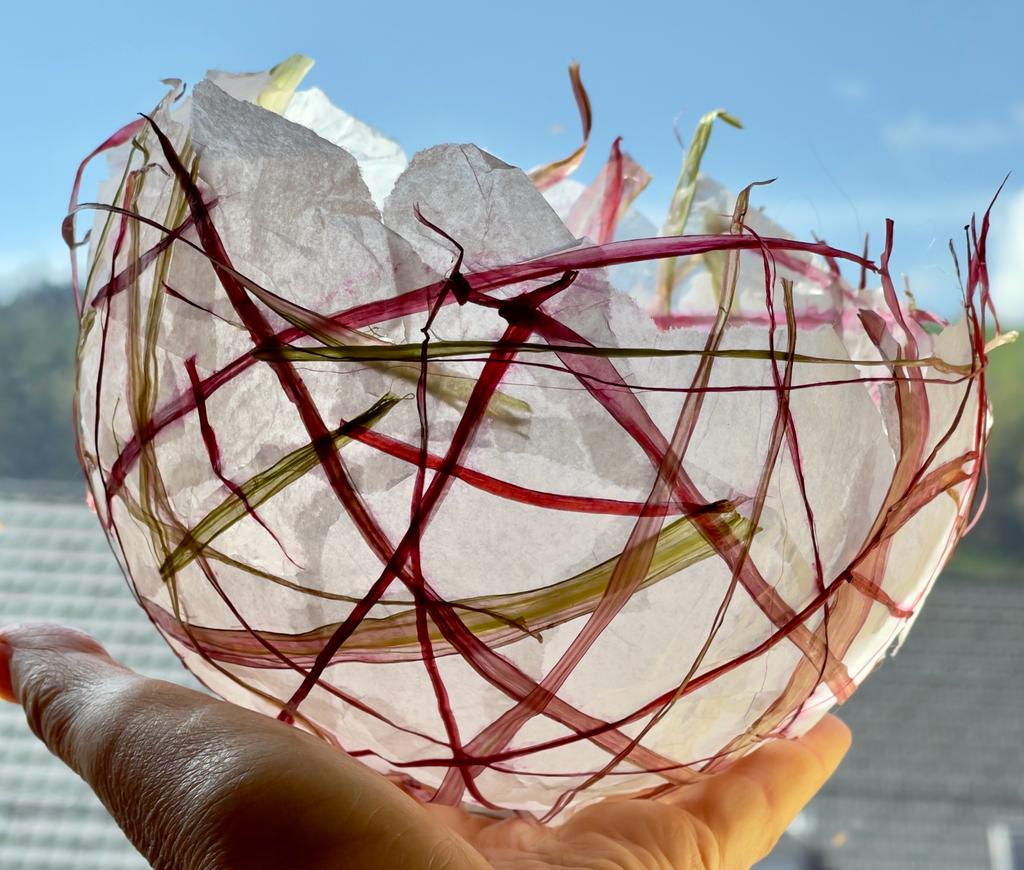
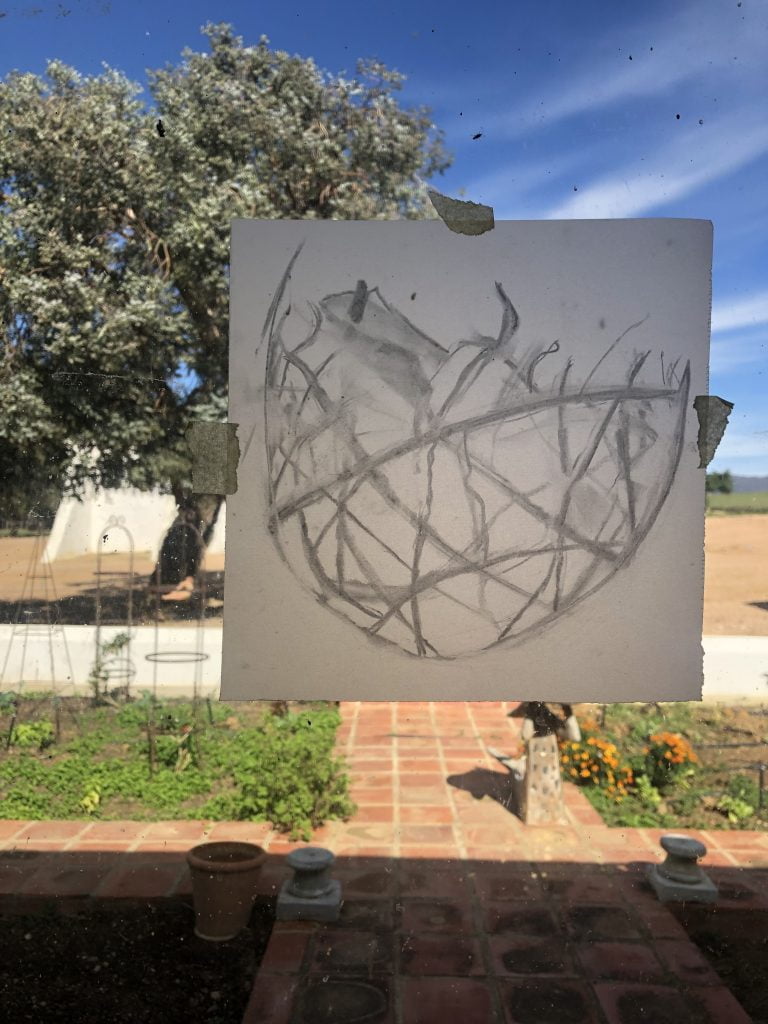
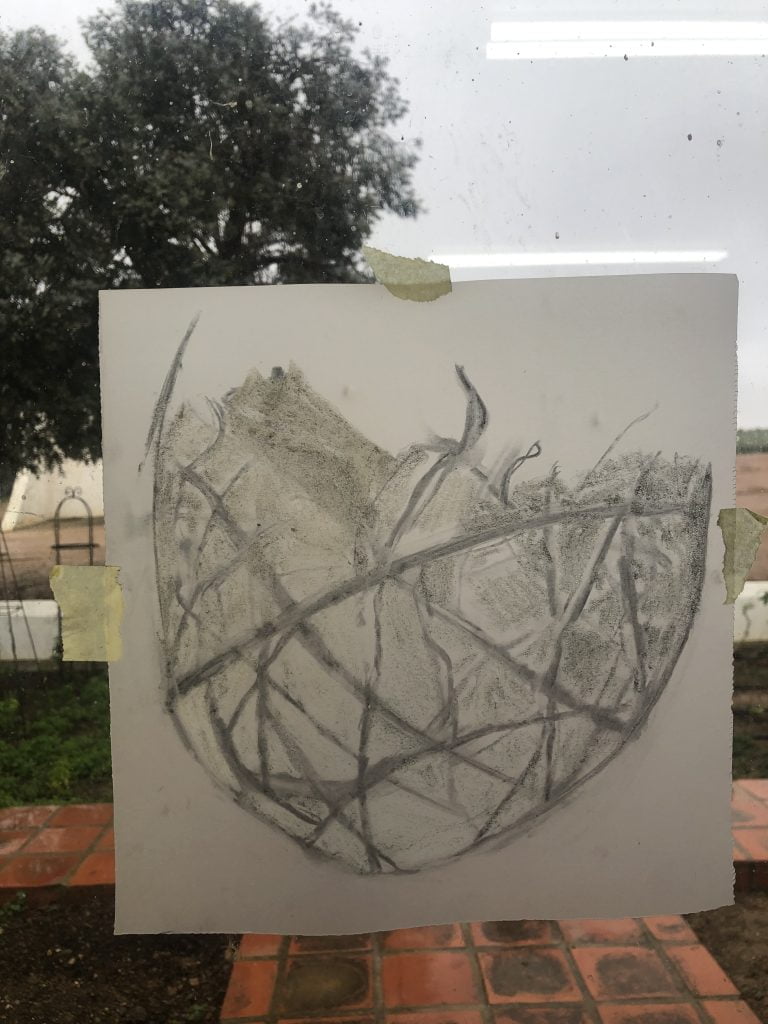
My favorite times of the day are early mornings and late evenings – I enjoy the quietness of my studio during these times and find that it acts as a provocation for my making. Late evenings are sometimes impulsive and productive after a morning of writing, reading or working. I start my day in the studio at around 7:30, bring a cup of coffee along, and typically start on sketches and drawings., or in summer, just a quick sit outside to enjoy the early morning around me. In between I will read/research and make notes on my blog. I prefer the quietness of my studio as a productive space. I would either work/make at a table or the easel. I have been keeping to a regular drawing time as the first making of the day. Over the months I have posted these daily drawings on my IG account. The latest work was mainly feathers and developed into more explorations.
LIST OF CONTENTS
Paints: watercoulor, oil and acrylic in trolley and in containers/white open boxes
Charcoal, pencils, ink pens, coloured pencils and graphite: all thicknesses as well as pastels in a set of drawers on my working table
Primers, varnish, extenders, gells and ink on shelves
Paper, canvas, velour, japanese paper in drawers boards and bigger canvas and on shelves and againts wall
Desk with computer, laptop, iPad and brigh light
Working table with shelves – mostly current work in heaps on the table
Working trolley table with two shelves – printing, cutting and storing of paper/canvas and inks
Two chairs
Small table for display or cutting, glue, beads, feathers
Wundercabinet with works and objects found
Bookshelf, one a glass cabinet end the other a floor shelf with books
ACTIONS
Sitting at a desk and working on a laptop
Reading on my ipad and using referencing to study work
Walking to shelves to find books or materials like paper
Moving between desk and work tables
Talking out paints, drawing tools and working on daily drawings or a bigger work
Clean brushes – walk to the kitchen area outside the studio
Work on floor occasionally – do cutting or assembling
Moving outside when drying work or doing cyanotype printing or caring for mushrooms
MAP of SPACE
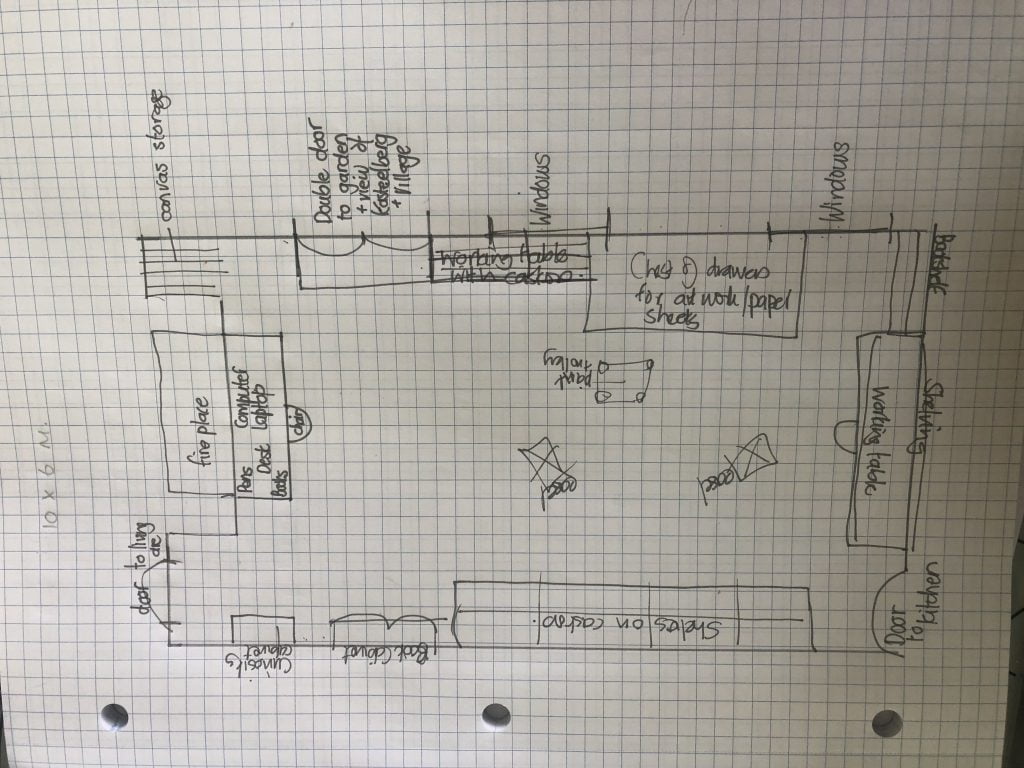
My studio is around 10 x 6 m in size and has good daylight coming in through the glass doors as well as two windows. I have lights in the ceilings as well as 1 moveable light on a tri pod.
Exercise 1.3: Visualising the Studio
My studio reminds me of a place in nature – there are trees, mountains, birds, animals, plants and sky to see and inspire me. It is a place of peace and chaos, it adapts to my own mood and feelings. I have lots of drawing materials and paints. I move between different works. I read, I reflect, I work, I suffer, I feel insecure, I feel excited, I enjoy and have pain – I continue and stay.
There are layers that are not seen – the works in drawers, the closed books, the written words in books – my mind still forming ideas.
It is best early mornings and late evenings – I enjoy the quietness and sounds outside drifting into my workspace. I feel close to the elements of the earth, I know this is my place, my home.
Notes about a Sunday in my studio, Langvlei Farm, April 2023
7:23 I walk into the studio and cut a piece of velour to make my daily drawing. I place it on my desk and look for a black surface in order to see the surface better. I think about transparency and how I enjoy choosing a think piece of charcoal and some white chalk to draw with.
7:38 I leave the studio and look if any mushrooms are growing in the garden. No new growth in outside work is observed.
7:52 Return to studio. I start drawing and work till 8:08 when I take a photo of my drawing and share it with fellow students on a WhatsApp group. ( We are 7 members and started the group about 1 month ago, call it The Daily Practice)
8:15. I organize my desk in order to start working on my studies. I have not been actively working on my studies for the last 3 months and it takes time to catch up to where I was. I have left open paragraphs in many of the exercises and need to read and revisited the research and the study materials. I look at visual work in my developing body of work which I will share with my tutor as part of Assignment Two.
9:50. I make coffee and share a cup with my husband. We are planning a short trip to Namibia and I need to focus and get back to finish my assignments – I am motivated by time and positive to stay focussed.
10:04 Back at desk and laptop and get back to ‘visualising the studio’ – my charcoal drawing will get some collage today.
10:16. Walk to shelf find scissor, glue and old drawings/printed paper to add collage to my recording of task. In between I type this note to keep a representation of a day in the studio up to date.
10:44 I wait for glue to dry, and think the work can be titled: Studio with emotions. I think the work is becoming too personal and not necessarily about the studio space, but more about myself and my inside space. I feel this is reality and part of what I carry into this space. I feel safe to keep it here. It also reminds me of many discarded works, some I kept, hoping I would come back and finish it. One is a painting of a woman floating, and another is a landscape done here outside my studio.
10:50. Looking at the two works I mentioned and contemplating on place and how I can rework.
10:56. Continue finishing off Project One of Part Two of Advanced Practice. I have a deadline and there is unfinished work within this part of my blog. I find getting back to work a bit overwhelming, but the study material is ‘talking to me’ as leftovers, collecting and gathering, and archiving seems very much part of my reality. Most of this is done so I can move faster and work to be done in the Research Points part of the study manual.
11:02. Work on Research Points
13:24 Take a lunch break and read social media posts on IG. (ps Lunch was pasta with fresh Shitake mushrooms and a dash of red chilli) On daily practice WA group we are having some discussion around beauty and truth, and emotions provoked by beauty that should be pushed…to the limits.
14:27 Back in the studio continue with research points of unfinished parts within my blog. Lots of reading and research time then writing the blog. Keep up the log in-between.
15:24 Coffee break – leave the studio to make coffee
15:42 Back in studio, continue listening to a video chat of an artist I am researching. Make notes for the blog.
16:03 Son pops in for a visit –
16:30 I leave the studio and drive out to do some mushroom foraging.
19:00 Use a feather drawing to make spore prints on – add 5 mushrooms to ‘print’ overnight.
19:16 Leave studio to have dinner
21:50. I came to the studio to make a small clay vessel I can decorate with feathers – thinking of the fur-covered teacup of Meret Oppenheim, Object, 1936.
22:35 Small pinch pot was made and feathers onto the rim of the pot. I am not happy with the outcome and will work on a better design – think I should make the pot with slabs or coils. The red clay stains the white feathers.
22.42 Make coffee (decaf) and make a list of mushrooms foraged today.
22:54 Start working on a blog for the rest of the work for Advanced Practice.
23:28 I plan to leave my studio for the day. I will now close my laptop, put off the lights, and close the door when I leave.
PS notes about movement in the studio during these time-based notes.
37 steps to the bathroom; 7 steps to the bookshelf on my left; 8 steps to the chest of drawers; 21 steps to the coffee machine
Exercise 1.4. Leftover and debris
I read the article by Briony Fer, The Scatter: Sculpture as Leftover. I felt drawn to the article as much of my work feels like offcuts and discarded materials inspired it. I arrange these objects in groups and keep them on shelves or in containers.
The vessel below was made with left over wrapping paper . I added some of my collected guinea fowl feathers as well as some discarded drawings of feathers to make the paper mache bowl.
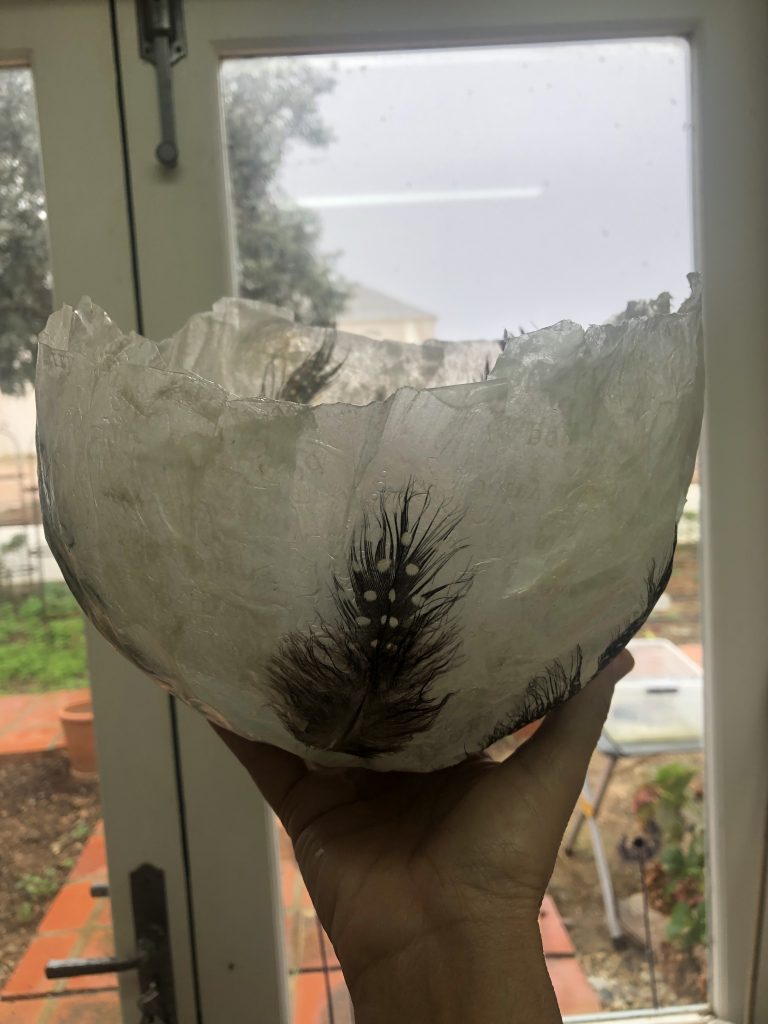
Thinking about the way I keep discarded materials, I know it could be better organized. I have two Ikea containers for paper and plastic which are stacked and have lids.
In Scatter words that came to mind are: ” chance, part objects in time rather than in space, suggest fractured rather than continuous time”. I do entirely resonate with the idea that these objects become a sensual encounter with the world at hand and show me how I lean more towards the chance than the systematic when making. I do sometimes leave my studio in a mess, so I can take off again where I left off – I now look at this as the traces of my making and thinking. I have to admit my writing table can do with organization, and some objects should be better organized to find things when needed. I also search for the odd masking tape, a bottle of glue, or scissors!
I could not access the video work, Mapping the Studio 1 by Bruce Nauman, but I found some images on the Frieze.com site. (see image below). On this site, I read: ” The piece consists of seven large-scale DVD projections of footage shot at night in the artist’s studio in Galisteo, New Mexico. Multiple audio tracks accompany the piece.” The video footage was shot over several weeks, and sounds that came from dogs, cats, horses, coyotes, etc., were played. I read that it was at least six hours of video to be seen.
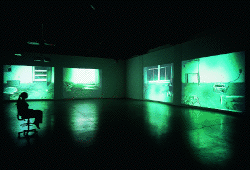
On the TATE website, I found notes that the artist made to act as a guide for the final editing of the tapes’ contents. In the summary part of this artwork on this website, they state that Newman said the work was triggered by the mice in his studio – so I can assume chance brought this work about. He set his camera up in different locations around his studio to see how the mouse would travel amongst his workspace. It is interesting to see his notations during recordings – stating the time of a sound, when a mouse enters, and when it leaves. He would also note the weather outside; comments like ‘a full moon, or ‘ it rainy outside’ would be documented. I would agree that these notes could be read as logbooks for the happenings in the video.
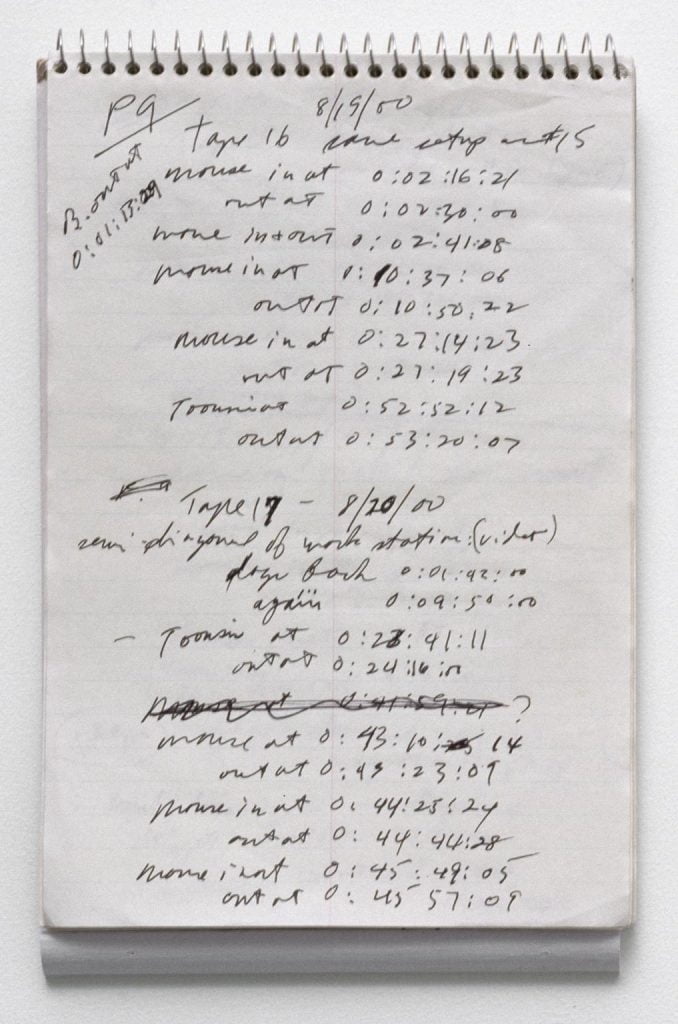
I feel the work reflects the private space in which the artist makes and thinks and where the work is conceptualized and made. In many situations, this is also a lonely space, it can make one feel isolated and become the space where one experiences fear insecurity, and concerns about how the work will be received and viewed/valued. I learned that the artist was never present in this video. I do like to think of this space as a statement that the artist is present – you will find the artist’s work and tools in his/her studio, but it is also an ambiguous space. In my situation and studio at home, I do like that people visit – but only briefly – I prefer to be alone when I work. It refers to the tension the artist has with viewers, I think. I want viewers to see the final work, but must it be in this space, my space? This is a feeling I am very aware of during this course and studies, as I have to invite my tutors and blog readers into my space if I want them to see and not only read about my studies and the work I make. I am also more aware of showing work or WIP using social media, such as Instagram. I think it brought me closer to potential viewers/customers, but as a student, it is also a place where I share my journey and learning and feel safe to show work.
Briony Fer, 2005 The Scatter: Sculpture as Leftover, From Materiality: Documents of Contemporary Art, ed Lange-Berndt. London. MIT Press. Pg 186-187
Exercise 1.5: Gathering, Collecting and Archiving
During the last few weeks, I have been very aware of how the visual material I have collected and my found objects have created new pairings with each other. I started working with feathers and this made me consider working with them as traces (messages or histories?)of things left behind, which could also form a connection with the spores mushrooms leave behind. I also realized that both are found in natural materials in many instances and that they can inform each other to make new work. I find that these materials act as provocation or prompt to start work.
I am also more inclined to go back to older work and revisit them by using them for collage, or rework them. I cannot ignore notes in notebooks, my sketchbooks, as well as small daily drawings for this same purpose as being ‘triggers’ to create work. During the last 3 months in my studio, my making became more introspective when I started working with feathers as my material. The making asked me to think about interconnectedness, kinship, grief, and vulnerability. Bringing feathers into my materials made me want to do more 3d work. I recently started making vessels with feathers, and I see these as ‘communicators’ of my grief or places to hold it and give me a space to deal with it. I look at Haraway’s SF creatures as finding possibilities or the unfished in my making. I find that working with mushrooms, spore prints, lichen, and more recently feathers, are all born from the earth and carry stories about my own encounters and truths about dealing with them. Haraway on P178 writes about her father’s death: “I wanted to know how grief reworks truth to tell another truth. (When species meet)
I think by looking at the materials I am working with as ways I could show a form of the hybrid network between me (human) and my environment. I am concerned with nature and culture but also make them personal by linking loss, death, and grief as part of my own symbiotic relationships with the other, which is mushrooms, lichen, and feathers as material for making and connecting. I do believe that Haraway’s concept of kinship is not limited to biological connections, but that it embraces our connections with husbands/partners/lovers, close friends, grandchildren, our pets, animals in the wild or on the farm, as well as plants, insects, birds, sea life. I see it as those bonds or relationships which talk about caring and reciprocity.
I looked at the work of artist, Pontoppidan Pederson, who uses explicitly vessels as communicators in her making and who finds connections with the theories of Donna Harraway. Here she thought of how to sculpt in a ‘feminist way’, to play with new words, looking at things and fabulating. Her work, Donna’s Baby is a human-0id child which is drinking from a vessel and pays direct homage to Haraway through its title. This artist is from Denmark and works out of two converted barns on the outskirts of Aarhus. She mixes her clay and sculpts intuitively without ever sketching an idea in advance. She wants viewers to relate to her works as something almost human. As she says, “They have a soul.”(https://www.architecturaldigest.com/story/danish-artist-pernille-pontoppidan-pedersen-crafts-improvisational-ceramics-for-the-new-hostler-burrows-gallery)
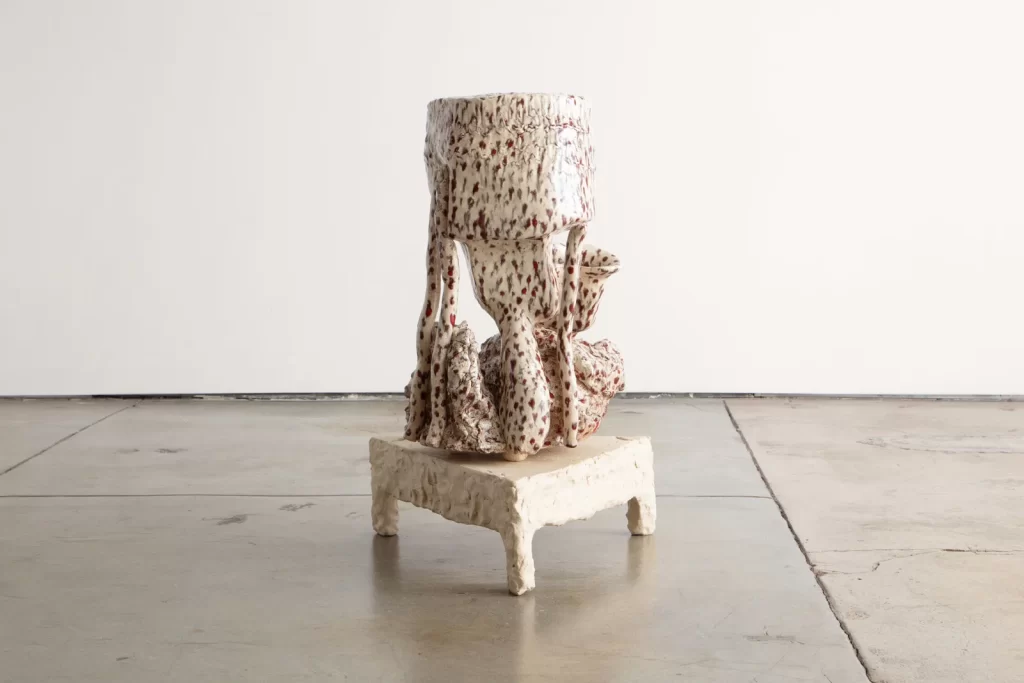
Connections: I am working here with a feminist posthumanist notion of embodied subjectivity, which relates to the ideas of Haraway about connectedness. I reread a quote by Haraway : “[N]othing is connected to everything; everything is connected to something”(Haraway, 2016, p. 31). I contemplate that I could, therefore, say that everything and everyone is connected through its connections with other things.
Haraway writes, “[B]odies as
objects of knowledge are material-semiotic nodes. Their boundaries materialize in social
interactions. Boundaries are drawn by mapping practices; ‘objects’ do not pre-exist as
such” (Haraway, 1988, p. 595). A similar approach is taken by feminist physicist Karen
Barad in her posthumanist notion of performativity framed as intra-action (Barad, 2003)
To ensure a liveable future for the following generations, we, as mortal “critters”,** need to link up ourselves with multiple configurations of places, times, matters and meanings so that new life can be “composted” from the planet-destroying Homo sapiens. Haraway, Donna: Staying with the Trouble: Making Kin in the Chthulucene, 2016.
** An American term for “all kinds of creatures”, used by Haraway for microbes, plants, animals, humans, non-humans and machines.